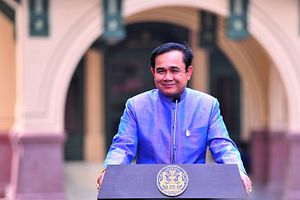As Thailand’s newly and controversially elected government takes shape, one of the key areas that junta leader turned civilian prime minister Prayut Chan-o-cha will face is how to deal with the economy, which has been of particular concern for the Southeast Asian state in recent years.
These aren’t good times for Thailand’s economy. Putting it lightly, a Bangkok Post article published August 3 opined that Prayut “may have bitten off more than he can chew” after recently deciding to chair the Council of Economic Ministers.
Data underscore this point. In the second quarter of 2019 the economy grew at the slowest rate (2.8 percent) in five years, we learned this week. As the Financial Times reported, agricultural output fell 1.1 percent, exports dropped 6.1 percent, and imports fell by 2.7 percent in the second quarter, as compared to the same time last year. Moreover, the central bank said it would lower its estimates for this year’s 2019 economic forecast, which was previously 3.3 percent.
So what has Prayut done? A few things are worth noting. For one, on August 6, the cabinet agreed to a fiscal budget for 2020 of 3.2 trillion baht ($103 billion), up 6.7 percent from the 2019 budget. It is clearly an investment budget. Roughly 20.5 percent (655 billion baht) of it will go to state investments, which also accounts for the majority of the 469 billion baht deficit.
It is that deficit economists will be concerned about. Thailand has seldom run a budget surplus, but Prayut’s budget is more costly than most. Public debt-to-GDP is only at 42 percent, which gives the government some flexibility as the cap is set at 60 percent. The government reckons its can ensure economic growth of between 3 and 4 percent in 2020, which could make up part of the deficit with increased revenue.
It is worth mentioning also as a broader point that in order to have a more balanced budget the sensible policy might have been to trim defense spending and put that money toward new stimulus works, if the economy were truly the focus. But the government has yet again committed to higher year-on-year military spending, which prompted a Bangkok Post editorial to declare: “Army budget out of control.”
The $10 billion stimulus package, more details of which were released this week, includes “aid for more than 900,000 farmers affected by drought, 1,000 baht ($30) handouts for tourism-related expenses, loans for small businesses and hikes in state welfare card subsidies,” AFP reported.
Some might venture that what we have here a cut-rate version of Thaksinomics – the name given to the policies of former prime ministers Thaksin Shinawatra and his sister, both of whom were ousted by military coups. None of this comes from the blue. In 2015, Prayut hired Thaksin’s economy architect Somkid Jatusripitak as an adviser, and from 2016 pursued many of the same policies under the junta regime.
So what then is “Prayutnomics” or “Prayutism,” one might inquire? For now, it seems like economic populism and a boot in the face, at best. And still the boot in the face and a little less money in the pocket, if things don’t go to plan. Debates over whether Thaksinomics was populist or redistributive – a slight but important distinction – can still be had today, not least because Prayut is repeating them. Writing in the Nikkei Asian Review in January, William Pesek made a compelling argument for why they should be considered populist. However, one can make the argument that Prayut’s policies are more populist in that he turned to them to remain in power, rather than to win power. It is more opportunistic to borrow than create. Nonetheless, one cannot separate politics from economics, and this is why Thais ought to be concerned.
One of the broader questions is what Prayut’s long-term motive is. Is it to turn around the economy and actually improve the lives of ordinary Thais? Is it to ensure Thais are richer in 10 or 20 years, than today? Or is it simply power?
For now, one suspects the latter. That is important because it means short-termism – one stays in power by offering populist policies, and when they fail, one has to look to something else. Short-termism may also be partly why we have seen Thailand weigh the benefits of the Chinese Belt and Road Initiative more than its costs. Prayut’s attendance at the second Belt and Road Initiative forum in May was viewed as a important signal that Prayut now wants to form closer ties to Beijing. The 20-year National Strategy, a blueprint to turn Thailand into a developed country by 2037, and which was actually made part of the 2017 constitution, in large part comes down to securing $45 billion in investment for the Eastern Economic Corridor development plan – and China has such money.
To be sure, things could well evolve given that the new government is just taking shape. But given what we have seen far and what we know about Prayut, it does not seem like Prayutnomics will deliver much for regular Thais and address the country’s problems in the years to come.

































